Zhixuan Chu
School of Cyber Science and Technology, Zhejiang University
Mitigating Social Bias in Large Language Models: A Multi-Objective Approach within a Multi-Agent Framework
Dec 20, 2024



Abstract:Natural language processing (NLP) has seen remarkable advancements with the development of large language models (LLMs). Despite these advancements, LLMs often produce socially biased outputs. Recent studies have mainly addressed this problem by prompting LLMs to behave ethically, but this approach results in unacceptable performance degradation. In this paper, we propose a multi-objective approach within a multi-agent framework (MOMA) to mitigate social bias in LLMs without significantly compromising their performance. The key idea of MOMA involves deploying multiple agents to perform causal interventions on bias-related contents of the input questions, breaking the shortcut connection between these contents and the corresponding answers. Unlike traditional debiasing techniques leading to performance degradation, MOMA substantially reduces bias while maintaining accuracy in downstream tasks. Our experiments conducted on two datasets and two models demonstrate that MOMA reduces bias scores by up to 87.7%, with only a marginal performance degradation of up to 6.8% in the BBQ dataset. Additionally, it significantly enhances the multi-objective metric icat in the StereoSet dataset by up to 58.1%. Code will be made available at https://github.com/Cortantse/MOMA.
Explainable Behavior Cloning: Teaching Large Language Model Agents through Learning by Demonstration
Oct 30, 2024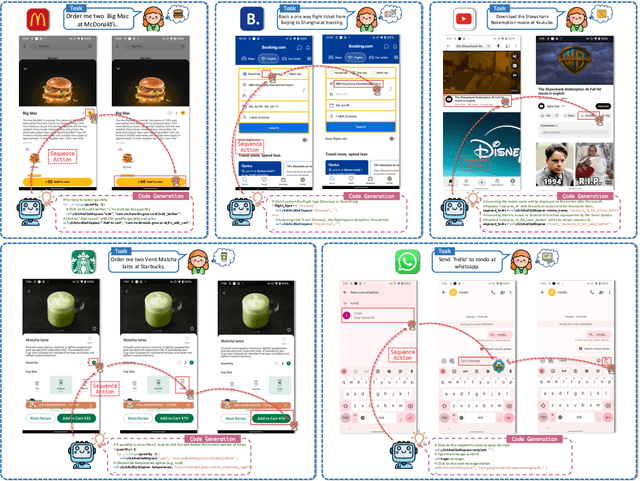
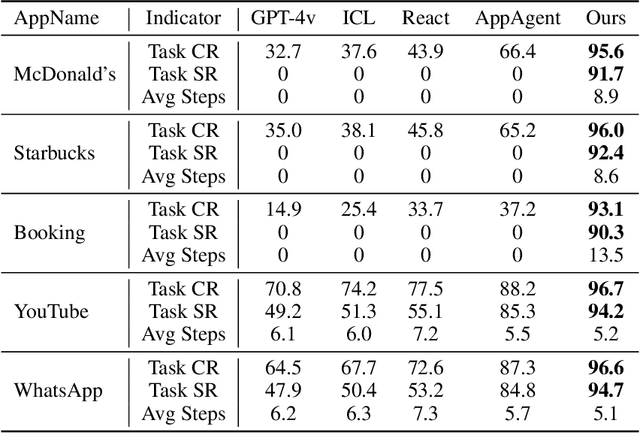
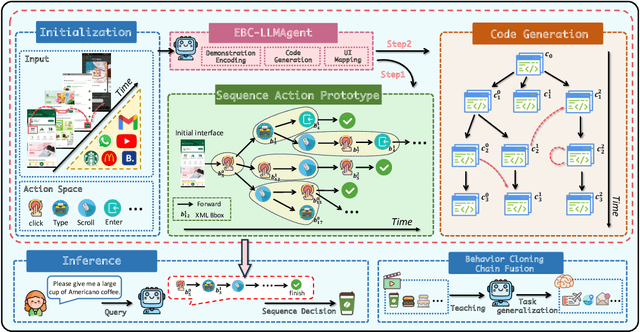

Abstract:Autonomous mobile app interaction has become increasingly important with growing complexity of mobile applications. Developing intelligent agents that can effectively navigate and interact with mobile apps remains a significant challenge. In this paper, we propose an Explainable Behavior Cloning LLM Agent (EBC-LLMAgent), a novel approach that combines large language models (LLMs) with behavior cloning by learning demonstrations to create intelligent and explainable agents for autonomous mobile app interaction. EBC-LLMAgent consists of three core modules: Demonstration Encoding, Code Generation, and UI Mapping, which work synergistically to capture user demonstrations, generate executable codes, and establish accurate correspondence between code and UI elements. We introduce the Behavior Cloning Chain Fusion technique to enhance the generalization capabilities of the agent. Extensive experiments on five popular mobile applications from diverse domains demonstrate the superior performance of EBC-LLMAgent, achieving high success rates in task completion, efficient generalization to unseen scenarios, and the generation of meaningful explanations.
TimeMixer++: A General Time Series Pattern Machine for Universal Predictive Analysis
Oct 21, 2024



Abstract:Time series analysis plays a critical role in numerous applications, supporting tasks such as forecasting, classification, anomaly detection, and imputation. In this work, we present the time series pattern machine (TSPM), a model designed to excel in a broad range of time series tasks through powerful representation and pattern extraction capabilities. Traditional time series models often struggle to capture universal patterns, limiting their effectiveness across diverse tasks. To address this, we define multiple scales in the time domain and various resolutions in the frequency domain, employing various mixing strategies to extract intricate, task-adaptive time series patterns. Specifically, we introduce a general-purpose TSPM that processes multi-scale time series using (1) multi-resolution time imaging (MRTI), (2) time image decomposition (TID), (3) multi-scale mixing (MCM), and (4) multi-resolution mixing (MRM) to extract comprehensive temporal patterns. MRTI transforms multi-scale time series into multi-resolution time images, capturing patterns across both temporal and frequency domains. TID leverages dual-axis attention to extract seasonal and trend patterns, while MCM hierarchically aggregates these patterns across scales. MRM adaptively integrates all representations across resolutions. This method achieves state-of-the-art performance across 8 time series analytical tasks, consistently surpassing both general-purpose and task-specific models. Our work marks a promising step toward the next generation of TSPMs, paving the way for further advancements in time series analysis.
FAMMA: A Benchmark for Financial Domain Multilingual Multimodal Question Answering
Oct 06, 2024



Abstract:In this paper, we introduce FAMMA, an open-source benchmark for financial multilingual multimodal question answering (QA). Our benchmark aims to evaluate the abilities of multimodal large language models (MLLMs) in answering questions that require advanced financial knowledge and sophisticated reasoning. It includes 1,758 meticulously collected question-answer pairs from university textbooks and exams, spanning 8 major subfields in finance including corporate finance, asset management, and financial engineering. Some of the QA pairs are written in Chinese or French, while a majority of them are in English. These questions are presented in a mixed format combining text and heterogeneous image types, such as charts, tables, and diagrams. We evaluate a range of state-of-the-art MLLMs on our benchmark, and our analysis shows that FAMMA poses a significant challenge for these models. Even advanced systems like GPT-4o and Claude-35-Sonnet achieve only 42\% accuracy. Additionally, the open-source Qwen2-VL lags notably behind its proprietary counterparts. Lastly, we explore GPT o1-style reasoning chains to enhance the models' reasoning capabilities, which significantly improve error correction. Our FAMMA benchmark will facilitate future research to develop expert systems in financial QA. The leaderboard is available at https://famma-bench.github.io/famma/ .
Multiscale Representation Enhanced Temporal Flow Fusion Model for Long-Term Workload Forecasting
Jul 29, 2024



Abstract:Accurate workload forecasting is critical for efficient resource management in cloud computing systems, enabling effective scheduling and autoscaling. Despite recent advances with transformer-based forecasting models, challenges remain due to the non-stationary, nonlinear characteristics of workload time series and the long-term dependencies. In particular, inconsistent performance between long-term history and near-term forecasts hinders long-range predictions. This paper proposes a novel framework leveraging self-supervised multiscale representation learning to capture both long-term and near-term workload patterns. The long-term history is encoded through multiscale representations while the near-term observations are modeled via temporal flow fusion. These representations of different scales are fused using an attention mechanism and characterized with normalizing flows to handle non-Gaussian/non-linear distributions of time series. Extensive experiments on 9 benchmarks demonstrate superiority over existing methods.
Causal Interventional Prediction System for Robust and Explainable Effect Forecasting
Jul 29, 2024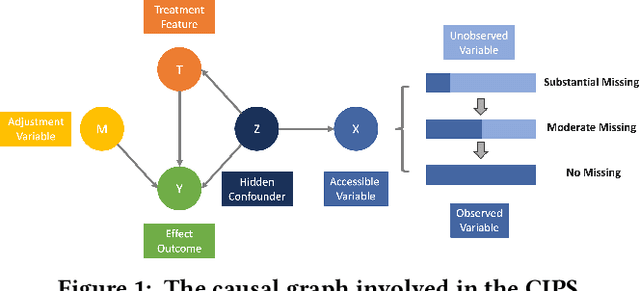
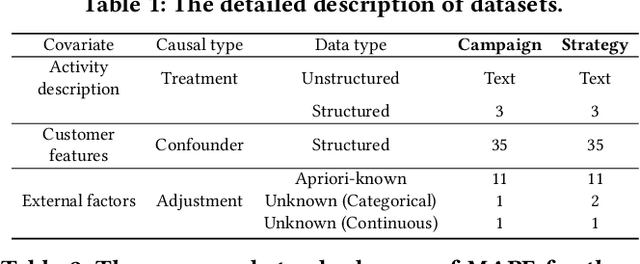

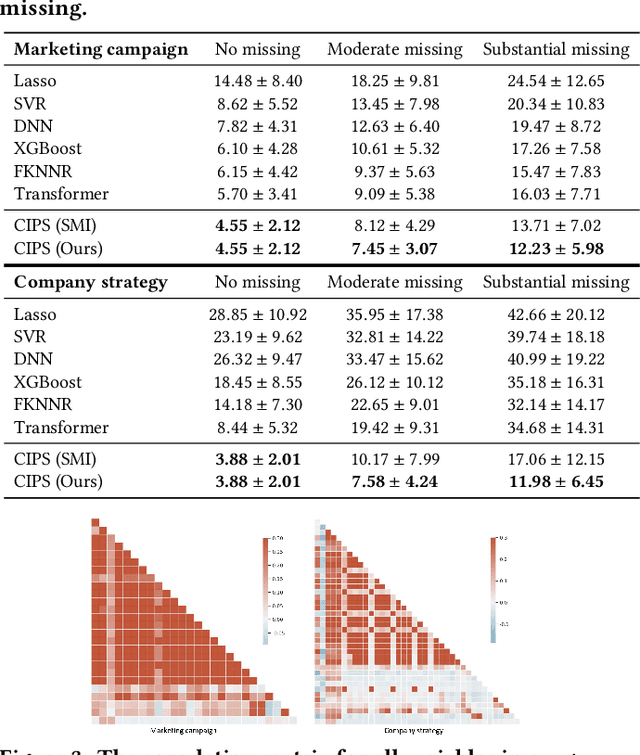
Abstract:Although the widespread use of AI systems in today's world is growing, many current AI systems are found vulnerable due to hidden bias and missing information, especially in the most commonly used forecasting system. In this work, we explore the robustness and explainability of AI-based forecasting systems. We provide an in-depth analysis of the underlying causality involved in the effect prediction task and further establish a causal graph based on treatment, adjustment variable, confounder, and outcome. Correspondingly, we design a causal interventional prediction system (CIPS) based on a variational autoencoder and fully conditional specification of multiple imputations. Extensive results demonstrate the superiority of our system over state-of-the-art methods and show remarkable versatility and extensibility in practice.
Prompt-Consistency Image Generation (PCIG): A Unified Framework Integrating LLMs, Knowledge Graphs, and Controllable Diffusion Models
Jun 24, 2024



Abstract:The rapid advancement of Text-to-Image(T2I) generative models has enabled the synthesis of high-quality images guided by textual descriptions. Despite this significant progress, these models are often susceptible in generating contents that contradict the input text, which poses a challenge to their reliability and practical deployment. To address this problem, we introduce a novel diffusion-based framework to significantly enhance the alignment of generated images with their corresponding descriptions, addressing the inconsistency between visual output and textual input. Our framework is built upon a comprehensive analysis of inconsistency phenomena, categorizing them based on their manifestation in the image. Leveraging a state-of-the-art large language module, we first extract objects and construct a knowledge graph to predict the locations of these objects in potentially generated images. We then integrate a state-of-the-art controllable image generation model with a visual text generation module to generate an image that is consistent with the original prompt, guided by the predicted object locations. Through extensive experiments on an advanced multimodal hallucination benchmark, we demonstrate the efficacy of our approach in accurately generating the images without the inconsistency with the original prompt. The code can be accessed via https://github.com/TruthAI-Lab/PCIG.
A Survey on Medical Large Language Models: Technology, Application, Trustworthiness, and Future Directions
Jun 06, 2024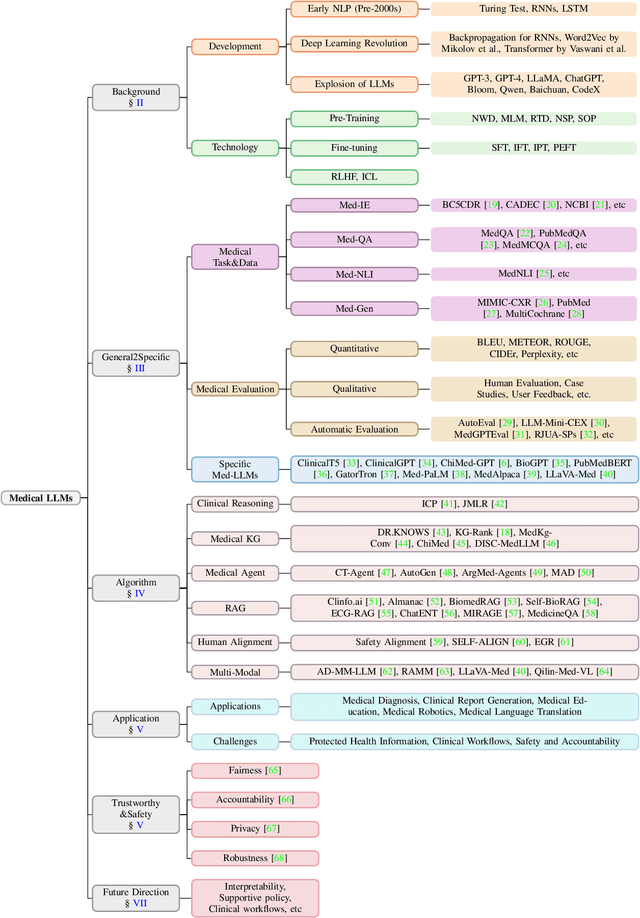
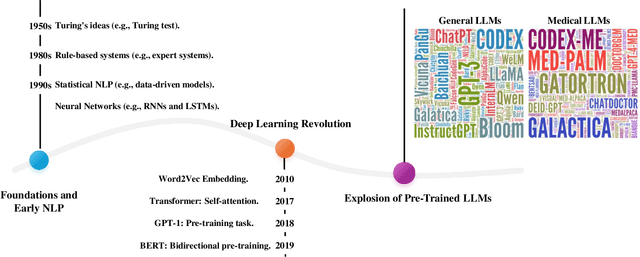


Abstract:Large language models (LLMs), such as GPT series models, have received substantial attention due to their impressive capabilities for generating and understanding human-level language. More recently, LLMs have emerged as an innovative and powerful adjunct in the medical field, transforming traditional practices and heralding a new era of enhanced healthcare services. This survey provides a comprehensive overview of Medical Large Language Models (Med-LLMs), outlining their evolution from general to the medical-specific domain (i.e, Technology and Application), as well as their transformative impact on healthcare (e.g., Trustworthiness and Safety). Concretely, starting from the fundamental history and technology of LLMs, we first delve into the progressive adaptation and refinements of general LLM models in the medical domain, especially emphasizing the advanced algorithms that boost the LLMs' performance in handling complicated medical environments, including clinical reasoning, knowledge graph, retrieval-augmented generation, human alignment, and multi-modal learning. Secondly, we explore the extensive applications of Med-LLMs across domains such as clinical decision support, report generation, and medical education, illustrating their potential to streamline healthcare services and augment patient outcomes. Finally, recognizing the imperative and responsible innovation, we discuss the challenges of ensuring fairness, accountability, privacy, and robustness in Med-LLMs applications. Finally, we conduct a concise discussion for anticipating possible future trajectories of Med-LLMs, identifying avenues for the prudent expansion of Med-LLMs. By consolidating above-mentioned insights, this review seeks to provide a comprehensive investigation of the potential strengths and limitations of Med-LLMs for professionals and researchers, ensuring a responsible landscape in the healthcare setting.
Towards Real World Debiasing: A Fine-grained Analysis On Spurious Correlation
May 30, 2024



Abstract:Spurious correlations in training data significantly hinder the generalization capability of machine learning models when faced with distribution shifts in real-world scenarios. To tackle the problem, numerous debias approaches have been proposed and benchmarked on datasets intentionally designed with severe biases. However, it remains to be asked: \textit{1. Do existing benchmarks really capture biases in the real world? 2. Can existing debias methods handle biases in the real world?} To answer the questions, we revisit biased distributions in existing benchmarks and real-world datasets, and propose a fine-grained framework for analyzing dataset bias by disentangling it into the magnitude and prevalence of bias. We observe and theoretically demonstrate that existing benchmarks poorly represent real-world biases. We further introduce two novel biased distributions to bridge this gap, forming a nuanced evaluation framework for real-world debiasing. Building upon these results, we evaluate existing debias methods with our evaluation framework. Results show that existing methods are incapable of handling real-world biases. Through in-depth analysis, we propose a simple yet effective approach that can be easily applied to existing debias methods, named Debias in Destruction (DiD). Empirical results demonstrate the superiority of DiD, improving the performance of existing methods on all types of biases within the proposed evaluation framework.
Sora Detector: A Unified Hallucination Detection for Large Text-to-Video Models
May 07, 2024



Abstract:The rapid advancement in text-to-video (T2V) generative models has enabled the synthesis of high-fidelity video content guided by textual descriptions. Despite this significant progress, these models are often susceptible to hallucination, generating contents that contradict the input text, which poses a challenge to their reliability and practical deployment. To address this critical issue, we introduce the SoraDetector, a novel unified framework designed to detect hallucinations across diverse large T2V models, including the cutting-edge Sora model. Our framework is built upon a comprehensive analysis of hallucination phenomena, categorizing them based on their manifestation in the video content. Leveraging the state-of-the-art keyframe extraction techniques and multimodal large language models, SoraDetector first evaluates the consistency between extracted video content summary and textual prompts, then constructs static and dynamic knowledge graphs (KGs) from frames to detect hallucination both in single frames and across frames. Sora Detector provides a robust and quantifiable measure of consistency, static and dynamic hallucination. In addition, we have developed the Sora Detector Agent to automate the hallucination detection process and generate a complete video quality report for each input video. Lastly, we present a novel meta-evaluation benchmark, T2VHaluBench, meticulously crafted to facilitate the evaluation of advancements in T2V hallucination detection. Through extensive experiments on videos generated by Sora and other large T2V models, we demonstrate the efficacy of our approach in accurately detecting hallucinations. The code and dataset can be accessed via GitHub.
 Add to Chrome
Add to Chrome Add to Firefox
Add to Firefox Add to Edge
Add to Edge